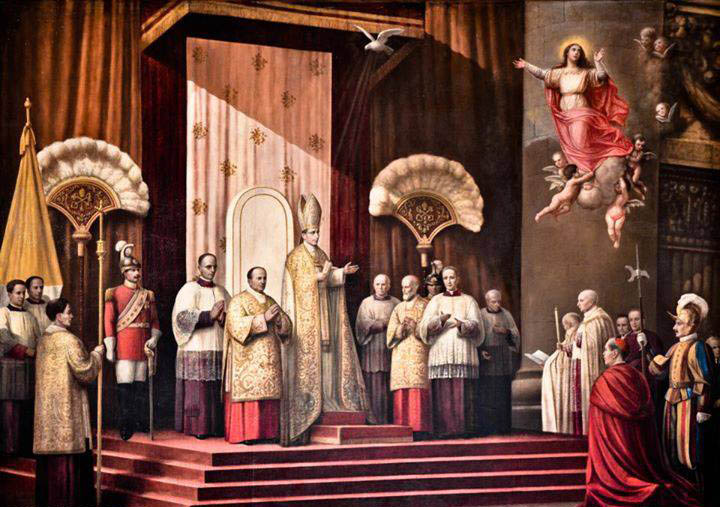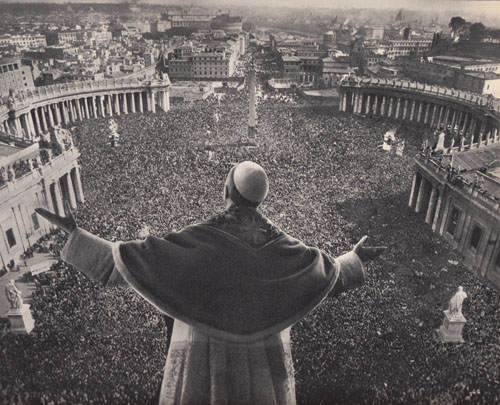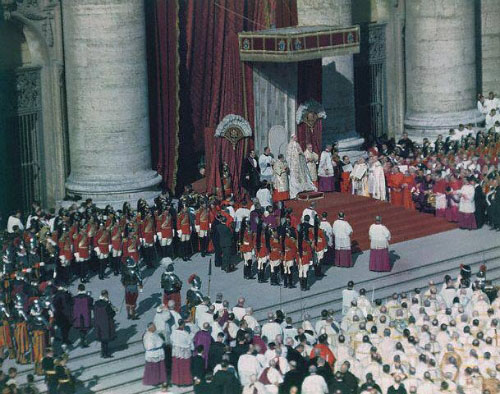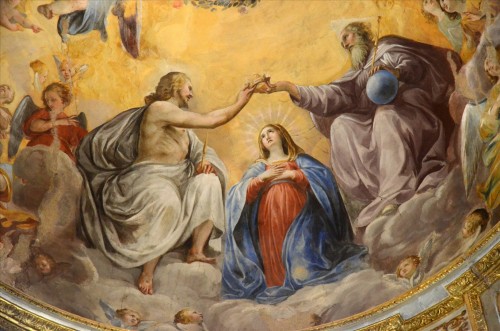

Ninety-six years had passed since Pope Pius IX stood in St. Peter's and proclaimed the dogma that Mary had been conceived without sin. Now, on the Feast of All Saints in 1950, another Pius, seated on a red damask covered throne set up before the obelisk in St. Peter's Square, was about to proclaim another dogma that adds to Mary's glory. This was Pope Pius XII, who had come to the throne of Peter in 1939.
Some 36 Cardinals, 600 Archbishops and Bishops, hundreds of noblemen and knights and statesmen, thousands of priests and Religious from hundreds of religious communities, and hundreds of thousands of lay people surrounded the Holy Father. The crowd of 700,000 overflowed the huge piazza into the streets beyond. The sun shone brilliantly from a sky of deepest blue.
As the Pope spoke in a loud clear voice, microphones carried his words to every part of the huge crowd in the square, to 80,000 people waiting inside St. Peter’s, and by radio to every part of the free world. "By the authority of Our Lord Jesus Christ, of the Blessed Apostles Peter and Paul, and by Our own authority, We pronounce, declare, and define that it is a divinely revealed dogma that the Immaculate Mother of God, ever Virgin Mary, when the course of Her earthly life was finished, was taken up body and soul into heavenly glory."
The dogma having been defined, the Holy Father declared, "If anyone, which God forbid, should dare voluntarily to deny or to call into doubt what has been defined by Us, let him know that he has fallen away completely from the divine and Catholic Faith."
 At the conclusion of these words, the bells of Rome's 400 churches rang out so loudly that they seemed to shatter the heavens. The Pope and his procession made their way into St. Peter's where the Pontiff was to say a Mass in honor of the Assumption. Great cheers came from the crowd as Pope Pius passed by. Tens of thousands of people then went to nearby churches to hear Mass at the same time the Pope celebrated Solemn Pontifical Mass within St. Peter's.
At the conclusion of these words, the bells of Rome's 400 churches rang out so loudly that they seemed to shatter the heavens. The Pope and his procession made their way into St. Peter's where the Pontiff was to say a Mass in honor of the Assumption. Great cheers came from the crowd as Pope Pius passed by. Tens of thousands of people then went to nearby churches to hear Mass at the same time the Pope celebrated Solemn Pontifical Mass within St. Peter's.
The fact that Mary's body had been assumed into Heaven had been accepted by virtually all Roman Catholics and even by many schismatics for centuries. It was not until the 20th century, however, that it was made a dogma of the Faith. This glorious event was the high point of the Holy Year of 1950, as well as one of the outstanding events in the Church's history.
From the earliest times Christians believed that the body of the Mother of God, who was never stained by original sin, had not been corrupted by death. There was a strong tradition that Mary died quietly and peacefully amidst the Apostles. Her death, according to this tradition, was not like other deaths which are accompanied by suffering, reluctance to leave this world, and a fear of the unknown. Her death, rather, was an act of pure love, an intense desire to be reunited with Her Son. A short time after Her burial, according to this tradition, the Apostles visited Her tomb and found it empty. Her body had been taken to Heaven to be reunited with Her soul.
The formal declaration avoids the question of Mary's death. The definition itself leaves us free to believe the old tradition, or to believe that She never died—that Her body and soul were assumed into Heaven at the same time. At any rate, She is in Heaven, soul and body, and there She reigns as Queen.
Petitions for a definition of the Assumption began to reach Rome only a few years after the Immaculate Conception had been proclaimed. Pope Pius IX, however, believed that the right time had not yet come. The petitions continued to pour in. In a period of 80 years they far exceeded the requests for a definition of the Immaculate Conception, although the latter had been spread over a period of 231 years. The petitions represented an overwhelming demand from millions of faithful all over the world.
The doctrine of the Immaculate Conception was an especially appropriate one for the 19th century. In 1854, man had elevated himself to the status of a god and thought he could solve all his own problems. The doctrine of the Immaculate Conception reminded man that he was born with original sin on his soul and that he was absolutely dependent upon God.
The bland optimism of the 19th century turned to bleak pessimism and despair in the 20th century. Instead of bringing us to a heaven on earth, science seems to have brought us to the gates of Hell. Man no longer thinks he can solve his own problems; now he wonders whether his problems can be solved at all. But Mary's Assumption reminds us that She who is in Heaven, body and soul, is our Mother, the Mother of God, the Queen of Heaven, and the eternal enemy of Satan. She loves us more than we can possibly love ourselves, and She is our powerful intercessor. What we ask in Her name, She will obtain for us. With God everything is possible, and God can refuse His Mother nothing. There is no reason for despair so long as Mary reigns as Queen of Heaven.
The Assumption also reminds us that our final goal is not on this earth but in Heaven. If we live according to God's laws, our body and soul will someday be reunited in Heaven, as Mary's are. The troubles we face in this world will be forgotten in the eternal happiness of Heaven.
Graham Greene, writing in Life magazine on the subject of the Assumption, says that the great heresy of his time was the unimportance of the individual: "Today the human body is regarded as expendable material, something to be eliminated wholesale by the atom bomb, a kind of anonymous carrion. After the first World War crosses marked the places where the dead lay, Allied and enemy; lights burned continually in the capitals of Europe over the graves of the unknown warriors. But no crosses today mark the common graves into which the dead of London and Berlin were shoveled... The definition of the Assumption proclaims again the doctrine of our resurrection, the eternal destiny of each human body, and again it is the history of Mary which maintains the doctrine in its clarity. The Resurrection of Christ can be regarded as the Resurrection of God, but the Resurrection of Mary forecasts the resurrection of each one of us."
 In proclaiming the dogma of the Assumption, Pope Pius XII has given us a solemn demonstration of the supreme spiritual authority of the Church, an authority which many men have ignored or forgotten. The action also attests to the unbroken link of faith that unites Catholics of this day with the faithful of ages past. Communism and secularism will pass away, but Christ’s Church will live till the end of time.
In proclaiming the dogma of the Assumption, Pope Pius XII has given us a solemn demonstration of the supreme spiritual authority of the Church, an authority which many men have ignored or forgotten. The action also attests to the unbroken link of faith that unites Catholics of this day with the faithful of ages past. Communism and secularism will pass away, but Christ’s Church will live till the end of time.
There is a striking parallel between conditions in 1854, when the Immaculate Conception was proclaimed, and conditions in 1950, when the Assumption was proclaimed. In 1854 the Church was beset by enemies on all sides, and many were freely predicting that its days were numbered. The Pope had numerous enemies in his own city of Rome. They had driven him from the city once, and were awaiting a chance to do so again. In the midst of these troubles the Church had one of Her most glorious moments—the proclamation of the Immaculate Conception.
In 1950 Pope Pius XII had already guided the Church through some of the most troubled times She had seen since the days of the catacombs. Wars, famines and persecutions—some of the greatest in history—had been the lot of the world during his reign. He had seen the Iron Curtain clank down on one country after another. The Italian Communists frequently paraded outside the Vatican gates and boasted of what they would do to the Church once they gained control of Italy. Thanks largely to the inspiring leadership of the Holy Father, the Communists lost the election of 1948 and failed to take over the country. They did not regard this defeat as permanent. They were waiting for another chance. So when, in this city of Rome, which had seen so much turmoil in recent years, Pope Pius XII proclaimed the dogma of the Assumption in 1950, the Church once again had one of Her most glorious moments in the face of the greatest trials.
On the day of Her glorious Assumption into Heaven, Mary received the crown of all Her graces. Truly we should rejoice, for, although our Mother has been taken from us, we have not lost Her. We simply send Her before us to prepare our place in Heaven and to acquire for us certain rights over the Heart of God. We may now say to Him with great confidence: "Our misery is great, it is true, for this earth is but a desolate valley, but it sends Thee today its most perfect treasure—a marvel that it could not be expected to produce—Mary, Thy Mother! Look, then, upon us with eyes of mercy, for the sake of this blessed flower of our garden which we offer Thee; it is the purest and the most beautiful this earth ever produced."
The triumph of Mary is also the triumph of Jesus. He will find His Mother again; He will once more be Her Son, because of Her presence. Jesus loved His Mother so much, how was it that He could separate Himself from Her? He did so through love of us, for having given Her to us as our Mother, it was but right that He should allow us to enjoy this ineffable gift. But the time has now come to recall that gift, and Jesus comes Himself to seek His Mother. Mary died of love; the longing to see Her Son and to be reunited with Him snapped Her thread of life. Jesus is now to accord Her a grand triumph. What passed between Jesus and His Mother at the moment of their meeting? Well, we know the joy of a mother and a loving son on meeting after a long separation. And Jesus, Who so desired to see His Mother once more—with what loving embraces He must have welcomed Her!
Jesus Himself introduces His Mother to the glorified state; He owes Her compensation. All Her life Mary was poor and despised, but now the hour has come when She is to be crowned with glory and honor. She enters the heavenly Jerusalem in splendor such as was never seen before: She enters by a special gate, open for Her alone; for it is not fitting that She should pass through the portal of the simple elect. If the Twelve Apostles are the twelve gates of Heaven, Mary is the royal entrance to that celestial country, the gate par excellence. O august and holy Gate—how good it is to pass through Thee! Doubtless the practice of the Faith will give us sure entrance into Heaven; but it will make our entrance there doubly certain if we confide ourselves to Mary’s clemency, which desires only our salvation. Let us seek to enter Heaven through this gate, and not count so much on our works and on our fulfillment of the law, for when we come to examine these we shall be forced to acknowledge them to be very imperfect.
 Jesus leads His Mother by the hand, up to the very Throne of God: "Behold, O Father, Her with whom Thou art associated by Thy choice of Her as My Mother—to give Me My humanity!" And the Father therewith crowns Her with Her three most beautiful titles: Queen, Mother, and Mediatrix. But in Mary’s diadem there are three pearls that shine with an even more dazzling brightness—the pearls of Her humility, of Her poverty, and of Her suffering.
Jesus leads His Mother by the hand, up to the very Throne of God: "Behold, O Father, Her with whom Thou art associated by Thy choice of Her as My Mother—to give Me My humanity!" And the Father therewith crowns Her with Her three most beautiful titles: Queen, Mother, and Mediatrix. But in Mary’s diadem there are three pearls that shine with an even more dazzling brightness—the pearls of Her humility, of Her poverty, and of Her suffering.
Mary was the most humble of all creatures, consequently in Heaven She is now the most glorious. If She is seated on the throne nearest to that of Her Divine Son, it is because She approached nearer than any other to the perfection of His humility. In Her earthly life She had been looked upon as one of Eve's sinful daughters—She who never said a word in self-justification!
No one was so poor as Mary, and never was poverty so meritorious, for She was the Mother of the King of Heaven and earth. In order to imitate the poverty of Jesus, She worked in Nazareth, begged in Egypt. What could have been more poverty stricken than the House of Loreto? Our Lord’s Justice owed Her compensation. Then, too, She inherits all the merits, all the graces of Her Son; She has the free disposal of these. All the graces of salvation, both natural and spiritual, will be given us by Mary; She is rich with the graces of God Himself.
And if Divine Justice did not oppose the inclinations of Her maternal Heart, the very gates of Hell would soon be closed. The demon has been forced to acknowledge that he is never sure of victory so long as he whom Mary protects retains a breath of life. She supplicates, importunes and snatches, as it were, from God the graces of mercy and pardon for the most hardened sinners.
Lastly, if happiness is in proportion to suffering, no one in Heaven is so happy as Mary, for having never loved as much as She, no one could have suffered so much. It was God’s Will that Mary should suffer a continual martyrdom. Simeon’s prophecy poisoned all her joy. From the moment of its utterance, Mary substituted for Jesus while He was still too young to suffer publicly.
And at the foot of the Cross She is nearest to Jesus in order that She may suffer more. Because Jesus wished to have Her nearest to Him in Heaven, He united Her more than any other creature to His sufferings and humiliations while on earth.
In a word, God has crowned Mary with glory and honor as the Masterpiece of His love. He alone is greater than She. But, in the midst of Her glory, Mary never forgets that She is our Mother. She ascended to Heaven before us to facilitate our entrance there and to conduct us thither. She Herself will come for us at that supreme moment of our lives—the hour of our death—if we only summon Her to our aid!
Contact us: smr@salvemariaregina.info
Visit also: www.marienfried.com